Ransomware Detection, Avoidance, and Mitigation Scheme: A Review and Future Directions
Abstract
1. Introduction
1.1. Motivation of the Study
- There is a sudden surge in extremely dangerous Ransomware attacks that have crippled most businesses and individuals alike. Ransomware poses a high threat and needs to be tackled at a global level.
- The existing literature contains solutions for mitigating either specific Ransomware or proposes generic solutions. A comprehensive analysis encompassing issues in securing individual users and corporations is lacking.
- Ransomware avoidance techniques are the most effective and need specialized focus as mitigation and recovery from Ransomware is increasingly complex.
1.2. Research Contributions
- We present DAM, a theoretical framework to review and classify the tools, techniques, and strategies to detect, avoid and mitigate Ransomware.
- We put forward a continuum for the avoidance of Ransomware. This continuum can be adopted by different organizations ranging from critical deployments to small-scale organizations.
- Finally, we present a case study on one of the recent Ransomware strands, Djvu, where we discuss the technical aspects related to Djvu and then apply the DAM framework to consider potential containment/response strategies.
1.3. Paper Organization
2. Background
2.1. How Deadly the Ransomware Is?
2.2. Ransomware Sources
2.2.1. Email Attachments
2.2.2. Removable Media
2.2.3. Malvertising
2.2.4. Social Media & SMS
2.2.5. Ransomware as a Service
2.3. Ransomware Types
2.3.1. Crypto Ransomware
2.3.2. Locker Ransomware
2.4. Ransomware Operation
2.4.1. Infection
2.4.2. Encryption/Locking
2.4.3. Demand
2.4.4. Result
2.5. The Role of Cryptocurrencies
3. State-of-the-Art
4. The DAM Framework for Ransomware Defense
4.1. Detection Techniques
4.1.1. Static Analysis
4.1.2. Dynamic Analysis
4.2. Ransomware Avoidance Techniques
4.2.1. Regular Patches and Updates
4.2.2. Avoid e-Mails from Unknown Sources and Attachments
4.2.3. Disable JavaScript and Java for Browsers
4.2.4. Controlled Folder Access
4.3. Ransomware Mitigation Techniques
5. The Notorious Djvu Ransomware: A Case Study
5.1. The Djvu Modus Operandi
5.2. Tackling Djvu
6. Future Directions in Ransomware Protection
6.1. Browsers as the First Line on Defense
6.2. Trusted and Non Trusted Sources
6.3. Avoiding Privilege Escalation in Windows Based Platforms
6.4. Adoption of AI Based Chat-Bot Assistants for Ensuring Cyber-Hygiene among Users
6.5. Use of a Sanitized Software Download Service
6.6. Backup and Restore
6.7. CVE Monitoring
7. Conclusions
Author Contributions
Funding
Institutional Review Board Statement
Informed Consent Statement
Data Availability Statement
Conflicts of Interest
References
- Johnson, B. The Growing Menace of Ransomware. Available online: https://alliantnational.com/the-growing-menace-of-ransomware/ (accessed on 26 August 2021).
- Sophos. The State of Ransomware 2020. Available online: https://www.sophos.com/en-us/medialibrary/Gated-Assets/white-papers/sophos-the-state-of-ransomware-2020-wp.pdf (accessed on 14 December 2020).
- AH, A.K.; CC, Y.Y.; Ping, M.; Zahra, F. Cybersecurity Issues and Challenges during COVID-19 Pandemic. Available online: https://cyber-trust.eu/2021/01/07/cyber-security-challenges-during-the-covid-19-pandemic/ (accessed on 7 January 2021).
- Kalaimannan, E.; John, S.; DuBose, T.; Pinto, A. Influences on ransomware’s evolution and predictions for the future challenges. J. Cyber Secur. Technol. 2016, 1, 1–9. [Google Scholar] [CrossRef]
- Emm, D. Cracking the code: The history of Gpcode. Comput. Fraud. Secur. 2008, 2008, 15–17. [Google Scholar] [CrossRef]
- Bodkhe, U.; Tanwar, S. Secure data dissemination techniques for IoT applications: Research challenges and opportunities. Softw. Pract. Exp. 2021, 51, 2469–2491. [Google Scholar] [CrossRef]
- Purplesec. The Growing Threat of Ransomware. Available online: https://purplesec.us/resources/cyber-security-statistics/ransomware/ (accessed on 19 December 2020).
- Braue, D. Global Ransomware Damage Costs Predicted to Exceed 265 Billion by 2031. Available online: https://cybersecurityventures.com/global-ransomware-damage-costs-predicted-to-reach-250-billion-usd-by-2031/ (accessed on 3 June 2021).
- Maennel, K.; Mäses, S.; Maennel, O. Cyber Hygiene: The Big Picture. In Proceedings of the 23rd Nordic Conference, NordSec 2018, Oslo, Norway, 28–30 November 2018; pp. 291–305. [Google Scholar] [CrossRef]
- Tischer, M.; Durumeric, Z.; Foster, S.; Duan, S.; Mori, A.; Bursztein, E.; Bailey, M. Users Really Do Plug in USB Drives They Find. In Proceedings of the 2016 IEEE Symposium on Security and Privacy (SP), San Jose, CA, USA, 23–26 May 2016; pp. 306–319. [Google Scholar] [CrossRef]
- Lee, J.K.; Moon, S.Y.; Park, J.H. CloudRPS: A cloud analysis based enhanced ransomware prevention system. J. Supercomput. 2017, 73, 3065–3084. [Google Scholar] [CrossRef]
- Sood, A.K.; Enbody, R.J. Malvertising–exploiting web advertising. Comput. Fraud. Secur. 2011, 2011, 11–16. [Google Scholar] [CrossRef]
- Hernandez-Castro, J.; Cartwright, E.; Stepanova, A. Economic Analysis of Ransomware. SSRN Electron. J. 2017, 1–14. [Google Scholar] [CrossRef]
- Mansfield-Devine, S. Ransomware: Taking businesses hostage. Netw. Secur. 2016, 2016, 8–17. [Google Scholar] [CrossRef]
- Hathaliya, J.J.; Tanwar, S.; Tyagi, S.; Kumar, N. Securing electronics healthcare records in Healthcare 4.0: A biometric-based approach. Comput. Electr. Eng. 2019, 76, 398–410. [Google Scholar] [CrossRef]
- Salvi, M.H.U.; Kerkar, M.R.V. Ransomware: A cyber extortion. Asian J. Converg. Technol. (AJCT) 2016, 2, 1–6. [Google Scholar]
- Yaqoob, I.; Ahmed, E.; Habib ur Rehman, M.; Ahmed, A.I.A.; Al-Garadi, M.; Imran, M.; Guizani, M. The rise of ransomware and emerging security challenges in the Internet of Things. Comput. Netw. 2017, 129, 444–458. [Google Scholar] [CrossRef]
- Simmons, G.J. Symmetric and asymmetric encryption. ACM Comput. Surv. (CSUR) 1979, 11, 305–330. [Google Scholar] [CrossRef]
- Yassein, M.B.; Aljawarneh, S.; Qawasmeh, E.; Mardini, W.; Khamayseh, Y. Comprehensive study of symmetric key and asymmetric key encryption algorithms. In Proceedings of the 2017 International Conference on Engineering and Technology (ICET), Antalya, Turkey, 21–24 August 2017; pp. 1–7. [Google Scholar]
- Bajpai, P.; Sood, A.K.; Enbody, R. A key-management-based taxonomy for ransomware. In Proceedings of the 2018 APWG Symposium on Electronic Crime Research (eCrime), San Diego, CA, USA, 15–17 May 2018; pp. 1–12. [Google Scholar]
- Savage, K.; Coogan, P.; Lau, H. The Evolution of Ransomware; Symantec: Mountain View, CA, USA, 2015. [Google Scholar]
- Labuschagne, W.; Burke, I.; Veerasamy, N.; Eloff, M. Design of cyber security awareness game utilizing a social media framework. In Proceedings of the 2011 Information Security for South Africa, Johannesburg, South Africa, 15–17 August 2011; pp. 1–9. [Google Scholar]
- Hampton, N.; Baig, Z.A. Ransomware: Emergence of the Cyber-Extortion Menace. In Proceedings of the 13th Australian Information Security Management Conference, Perth, Australia, 30 November–2 December 2015; pp. 47–56. [Google Scholar] [CrossRef]
- Tanwar, S.; Vora, J.; Tyagi, S.; Kumar, N.; Obaidat, M. A systematic review on security issues in vehicular ad hoc network. Secur. Priv. 2018, 1, 1–26. [Google Scholar] [CrossRef]
- Aurangzeb, S.; Aleem, M.; Iqbal, M.A.; Islam, M.A. Ransomware: A survey and trends. J. Inf. Assur. Secur. 2017, 6, 48–58. [Google Scholar]
- Tailor, J.P.; Patel, A.D. A comprehensive survey: Ransomware attacks prevention, monitoring and damage control. Int. J. Res. Sci. Innov 2017, 4, 116–121. [Google Scholar]
- Tandon, A.; Nayyar, A. A comprehensive survey on ransomware attack: A growing havoc cyberthreat. In Data Management, Analytics and Innovation; Springer: Singapore, 2019; pp. 403–420. [Google Scholar]
- Genç, Z.A.; Lenzini, G.; Ryan, P. The Cipher, the Random and the Ransom: A Survey on Current and Future Ransomware. In Advances in Cybersecurity; University of Maribor Press: Maribor, Slovenia, 2017. [Google Scholar]
- Oz, H.; Aris, A.; Levi, A.; Uluagac, A.S. A Survey on Ransomware: Evolution, Taxonomy, and Defense Solutions. arXiv 2021, arXiv:2102.06249. [Google Scholar]
- Kok, S.; Abdullah, A.; Jhanjhi, N.; Supramaniam, M. Ransomware, threat and detection techniques: A review. Int. J. Comput. Sci. Netw. Secur. 2019, 19, 136. [Google Scholar]
- Subedi, K.P.; Budhathoki, D.R.; Dasgupta, D. Forensic analysis of ransomware families using static and dynamic analysis. In Proceedings of the 2018 IEEE Security and Privacy Workshops (SPW), San Francisco, CA, USA, 24 May 2018; pp. 180–185. [Google Scholar]
- Zheng, C.; Dellarocca, N.; Andronio, N.; Zanero, S.; Maggi, F. Greateatlon: Fast, static detection of mobile ransomware. In Proceedings of the International Conference on Security and Privacy in Communication Systems, Guangzhou, China, 10–12 October 2016; Springer: Berlin/Heidelberg, Germany, 2016; pp. 617–636. [Google Scholar]
- Andronio, N.; Zanero, S.; Maggi, F. HelDroid: Dissecting and Detecting Mobile Ransomware. In Research in Attacks, Intrusions, and Defenses; Bos, H., Monrose, F., Blanc, G., Eds.; Springer International Publishing: Cham, Switzerland, 2015; pp. 382–404. [Google Scholar]
- Arzt, S.; Rasthofer, S.; Fritz, C.; Bodden, E.; Bartel, A.; Klein, J.; Le Traon, Y.; Octeau, D.; McDaniel, P. Flowdroid: Precise context, flow, field, object-sensitive and lifecycle-aware taint analysis for android apps. ACM Sigplan Not. 2014, 49, 259–269. [Google Scholar] [CrossRef]
- Hsiao, S.C.; Kao, D.Y. The static analysis of WannaCry ransomware. In Proceedings of the 2018 20th International Conference on Advanced Communication Technology (ICACT), Chuncheon, Korea, 11–14 February 2018; pp. 153–158. [Google Scholar]
- Ferguson, J.; Kaminsky, D. Reverse Engineering Code with IDA Pro; Syngress: Seattle, WA, USA, 2008. [Google Scholar]
- Grossman, N. EternalBlue Everything There Is to Know. In Check Point Research; Available online: https://research.checkpoint.com/2017/eternalblue-everything-know/ (accessed on 29 September 2017).
- Sgandurra, D.; Muñoz-González, L.; Mohsen, R.; Lupu, E.C. Automated dynamic analysis of ransomware: Benefits, limitations and use for detection. arXiv 2016, arXiv:1609.03020. [Google Scholar]
- Cover, T.M. Elements of Information Theory; John Wiley & Sons: Hoboken, NJ, USA, 1999. [Google Scholar]
- Fernandez Maimo, L.; Huertas Celdran, A.; Perales Gomez, A.L.; Garcia Clemente, F.J.; Weimer, J.; Lee, I. Intelligent and dynamic ransomware spread detection and mitigation in integrated clinical environments. Sensors 2019, 19, 1114. [Google Scholar] [CrossRef]
- Kao, D.Y.; Hsiao, S.C. The dynamic analysis of WannaCry ransomware. In Proceedings of the 2018 20th International Conference on Advanced Communication Technology (ICACT), Chuncheon, Korea, 11–14 February 2018; pp. 159–166. [Google Scholar]
- Morato, D.; Berrueta, E.; Magaña, E.; Izal, M. Ransomware early detection by the analysis of file sharing traffic. J. Netw. Comput. Appl. 2018, 124, 14–32. [Google Scholar] [CrossRef]
- Johnson, A.; Haddad, R.J. Evading Signature-Based Antivirus Software Using Custom Reverse Shell Exploit. In Proceedings of the SoutheastCon 2021, Atlanta, GA, USA, 10–13 March 2021; pp. 1–6. [Google Scholar]
- Chen, Q.; Islam, S.R.; Haswell, H.; Bridges, R.A. Automated ransomware behavior analysis: Pattern extraction and early detection. In Proceedings of the International Conference on Science of Cyber Security, Nanjing, China, 9–11 August 2019; Springer: Berlin/Heidelberg, Germany, 2019; pp. 199–214. [Google Scholar]
- Analytica, O. US Pipeline Hack to Make Ransomware Risks a Priority; Emerald Expert Briefings: Oxford, UK, 2021. [Google Scholar]
- Imtiaz, S.I.; ur Rehman, S.; Javed, A.R.; Jalil, Z.; Liu, X.; Alnumay, W.S. DeepAMD: Detection and identification of Android malware using high-efficient Deep Artificial Neural Network. Future Gener. Comput. Syst. 2021, 115, 844–856. [Google Scholar] [CrossRef]
- Taheri, L.; Kadir, A.F.A.; Lashkari, A.H. Extensible android malware detection and family classification using network-flows and API-calls. In Proceedings of the 2019 International Carnahan Conference on Security Technology (ICCST), Chennai, India, 1–3 October 2019; pp. 1–8. [Google Scholar]
- Giles, J. Scareware: The inside story. New Sci. 2010, 205, 38–41. [Google Scholar] [CrossRef]
- Chien, E. Techniques of adware and spyware. In Proceedings of the Fifteenth Virus Bulletin Conference, Dublin, Ireland, 5–7 October 2005; Volume 47. [Google Scholar]
- Kok, S.; Abdullah, A.; Jhanjhi, N. Early detection of crypto-ransomware using pre-encryption detection algorithm. J. King Saud-Univ.-Comput. Inf. Sci. 2020, 1–16, Early Access. [Google Scholar] [CrossRef]
- Kumar, P.R.; Ramlie, R.E.B.H. Anatomy of Ransomware: Attack Stages, Patterns and Handling Techniques. In Proceedings of the International Conference on Computational Intelligence in Information System, Bandar Seri Begawan, Brunei Darussalam, 25–27 January 2021; Springer: Berlin/Heidelberg, Germany, 2021; pp. 205–214. [Google Scholar]
- Moussaileb, R.; Cuppens, N.; Lanet, J.L.; Le Bouder, H. Ransomware Network Traffic Analysis for Pre-encryption Alert. In Proceedings of the International Symposium on Foundations and Practice of Security, Toulouse, France, 5–7 November 2019; Springer: Berlin/Heidelberg, Germany, 2019; pp. 20–38. [Google Scholar]
- Al-rimy, B.A.S.; Maarof, M.A.; Prasetyo, Y.A.; Shaid, S.Z.M.; Ariffin, A.F.M. Zero-day aware decision fusion-based model for crypto-ransomware early detection. Int. J. Integr. Eng. 2018, 10, 82–88. [Google Scholar] [CrossRef]
- Ferrante, A.; Malek, M.; Martinelli, F.; Mercaldo, F.; Milosevic, J. Extinguishing ransomware-a hybrid approach to android ransomware detection. In Proceedings of the International Symposium on Foundations and Practice of Security, Nancy, France, 23–25 October 2017; Springer: Berlin/Heidelberg, Germany, 2017; pp. 242–258. [Google Scholar]
- Kara, I.; Aydos, M. Static and dynamic analysis of third generation cerber ransomware. In Proceedings of the 2018 International Congress on Big Data, Deep Learning and Fighting Cyber Terrorism (IBIGDELFT), Ankara, Turkey, 3–4 December 2018; pp. 12–17. [Google Scholar]
- Alhawi, O.M.; Baldwin, J.; Dehghantanha, A. Leveraging machine learning techniques for windows ransomware network traffic detection. In Cyber Threat Intelligence; Springer: Cham, Switzerland, 2018; pp. 93–106. [Google Scholar]
- Chen, Z.G.; Kang, H.S.; Yin, S.N.; Kim, S.R. Automatic ransomware detection and analysis based on dynamic API calls flow graph. In Proceedings of the International Conference on Research in Adaptive and Convergent Systems, Krakow, Poland, 20–23 September 2017; pp. 196–201. [Google Scholar]
- Hwang, J.; Kim, J.; Lee, S.; Kim, K. Two-Stage Ransomware Detection Using Dynamic Analysis and Machine Learning Techniques. Wirel. Pers. Commun. 2020, 112, 2597–2609. [Google Scholar] [CrossRef]
- Kharaz, A.; Arshad, S.; Mulliner, C.; Robertson, W.; Kirda, E. {UNVEIL}: A large-scale, automated approach to detecting ransomware. In Proceedings of the 25th {USENIX} Security Symposium ({USENIX} Security 16), Austin, TX, USA, 10–12 August 2016; pp. 757–772. [Google Scholar]
- Richardson, R.; North, M.M. Ransomware: Evolution, mitigation and prevention. Int. Manag. Rev. 2017, 13, 10. [Google Scholar]
- Vora, J.; Italiya, P.; Tanwar, S.; Tyagi, S.; Kumar, N.; Obaidat, M.S.; Hsiao, K. Ensuring Privacy and Security in E-Health Records. In Proceedings of the 2018 International Conference on Computer, Information and Telecommunication Systems (CITS), Colmar, France, 11–13 July 2018; pp. 1–5. [Google Scholar] [CrossRef]
- Cabaj, K.; Mazurczyk, W. Using software-defined networking for ransomware mitigation: The case of cryptowall. IEEE Netw. 2016, 30, 14–20. [Google Scholar] [CrossRef]
- Zimba, A.; Wang, Z.; Simukonda, L. Towards data resilience: The analytical case of crypto ransomware data recovery techniques. Int. J. Inf. Technol. Comput. Sci. 2018, 10, 40–51. [Google Scholar] [CrossRef][Green Version]
- Xu, T.; Chen, Y.; Zhao, J.; Fu, X. Cuckoo: Towards decentralized, socio-aware online microblogging services and data measurements. In Proceedings of the 2nd ACM International Workshop on Hot Topics in Planet-Scale Measurement, San Francisco, CA, USA, 15 June 2010; pp. 1–6. [Google Scholar]
- Hathaliya, J.J.; Tanwar, S. An exhaustive survey on security and privacy issues in Healthcare 4.0. Comput. Commun. 2020, 153, 311–335. [Google Scholar] [CrossRef]
- Baykara, M.; Sekin, B. A novel approach to ransomware: Designing a safe zone system. In Proceedings of the 2018 6th International Symposium on Digital Forensic and Security (ISDFS), Antalya, Turkey, 22–25 March 2018; pp. 1–5. [Google Scholar]
- Akbanov, M.; Vassilakis, V.G.; Logothetis, M.D. Ransomware detection and mitigation using software-defined networking: The case of WannaCry. Comput. Electr. Eng. 2019, 76, 111–121. [Google Scholar] [CrossRef]
- Sophos. Endpoint Security Buyers Guide. Available online: https://www.enterpriseav.com/datasheets/endpointbuyersguide.pdf (accessed on 18 June 2021).
- LLC, McAfee Mitigation of Ransomware. U.S. Patent 20180018458A1, 10 November 2020.
- EMC, Dell Detecting and Protecting against Ransomware. U.S. Patent 10819738B2, 27 October 2018.
- Bhat, O.; Yeprem, Z.; Lingesh, V. CS 6501 Project Report–Hoos’ Upto No Good. Available online: https://www.researchgate.net/profile/Omkar-Bhat/publication/333907927_Comparison_of_3_Reverse_Engineering_Tools/links/5d0bf123299bf1547c7154e4/Comparison-of-3-Reverse-Engineering-Tools.pdf (accessed on 18 June 2021).
- Ren, A.L.Y.; Liang, C.T.; Hyug, I.J.; Broh, S.N.; Jhanjhi, N. A Three-Level Ransomware Detection and Prevention Mechanism. EAI Endorsed Trans. Energy Web 2020, 7, 1–7. [Google Scholar] [CrossRef]
- Simoiu, C.; Nguyen, W.; Durumeric, Z. An Empirical Analysis of HTTPS Configuration Security. arXiv 2021, arXiv:2111.00703. [Google Scholar]
- Amazon. Available online: www.alexa.com (accessed on 18 June 2021).
- Microsoft. Next-Gen Ransomware Protection with Windows 10 Creators Update Ransomware in 2017: Growing in Sophistication and Reach. Available online: https://download.microsoft.com/download/8/A/3/8A3ADCCE-C141-4E31-AB0D-26AA990D70A0/Next_gen_ransomware_protection_with_Windows_10_Creators_Update_EN_US.pdf (accessed on 17 August 2021).
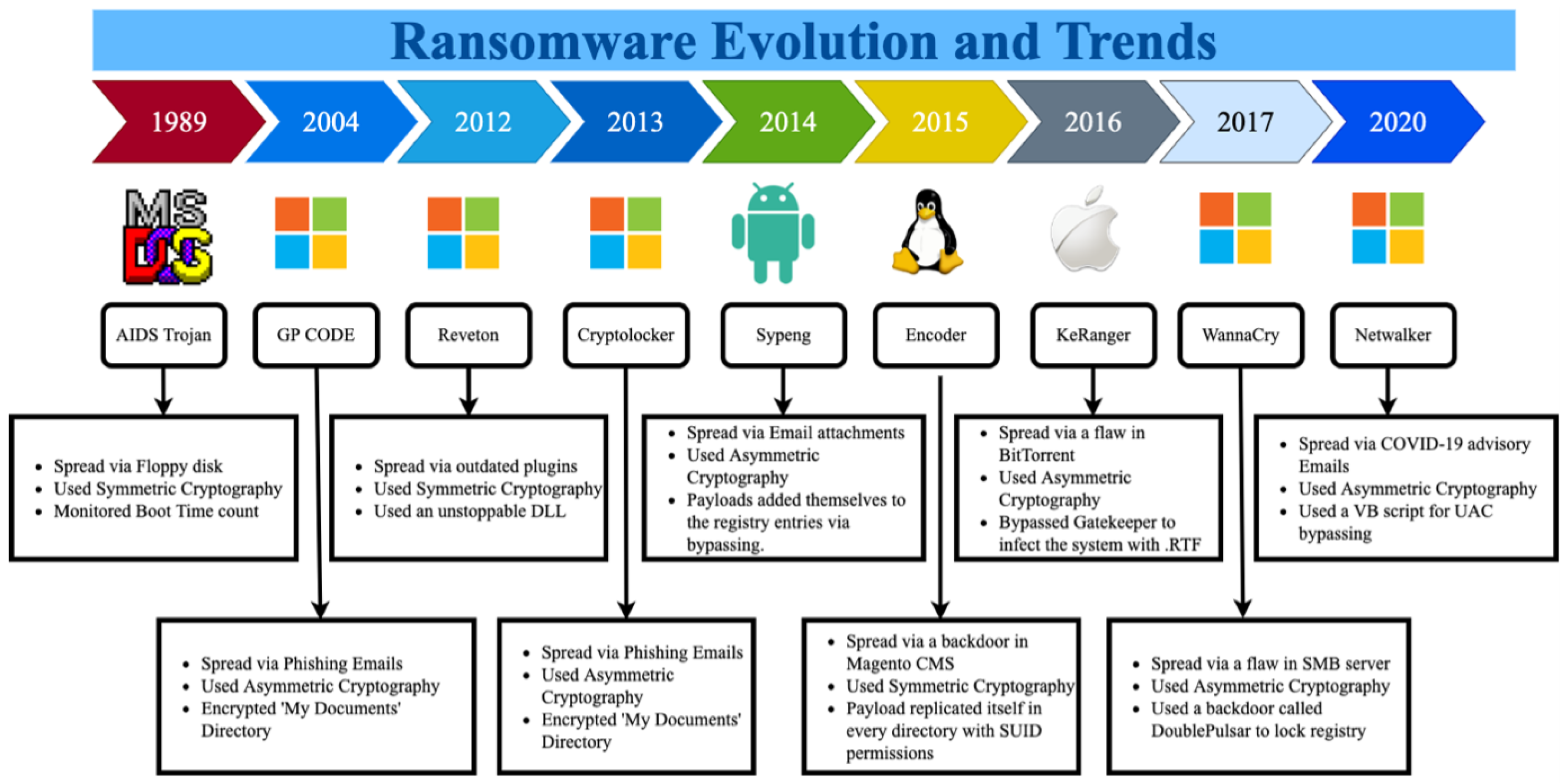
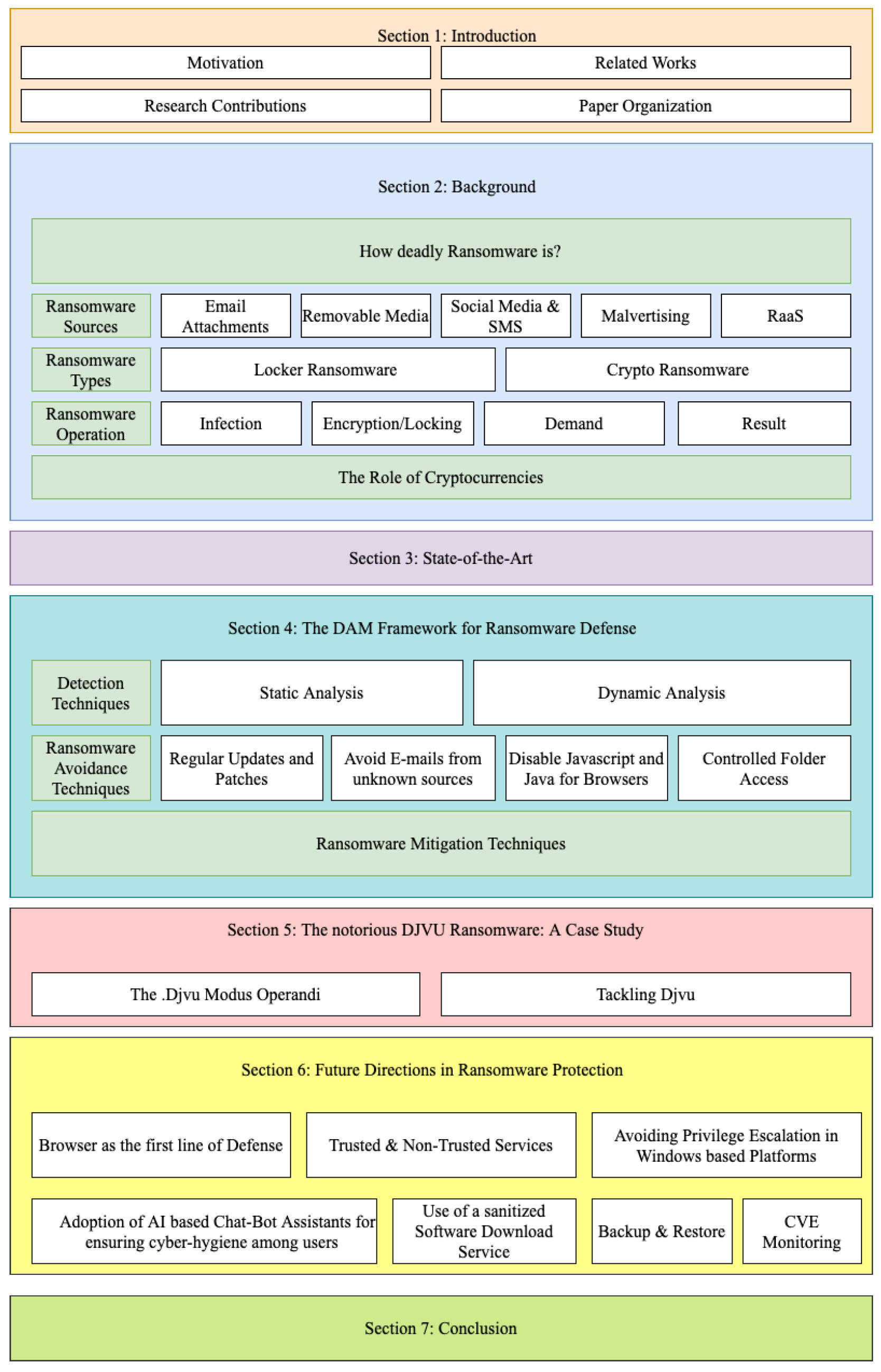
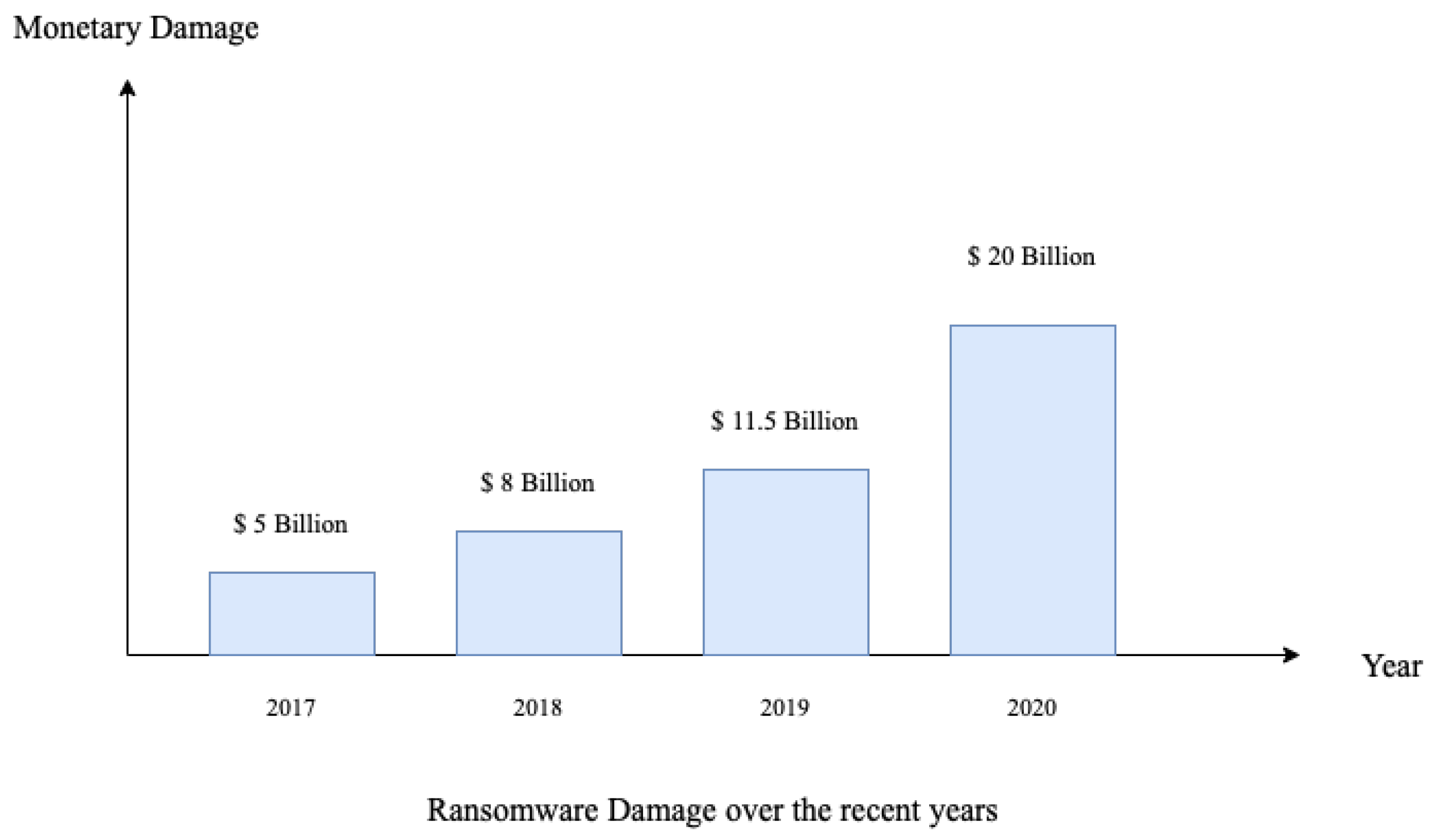
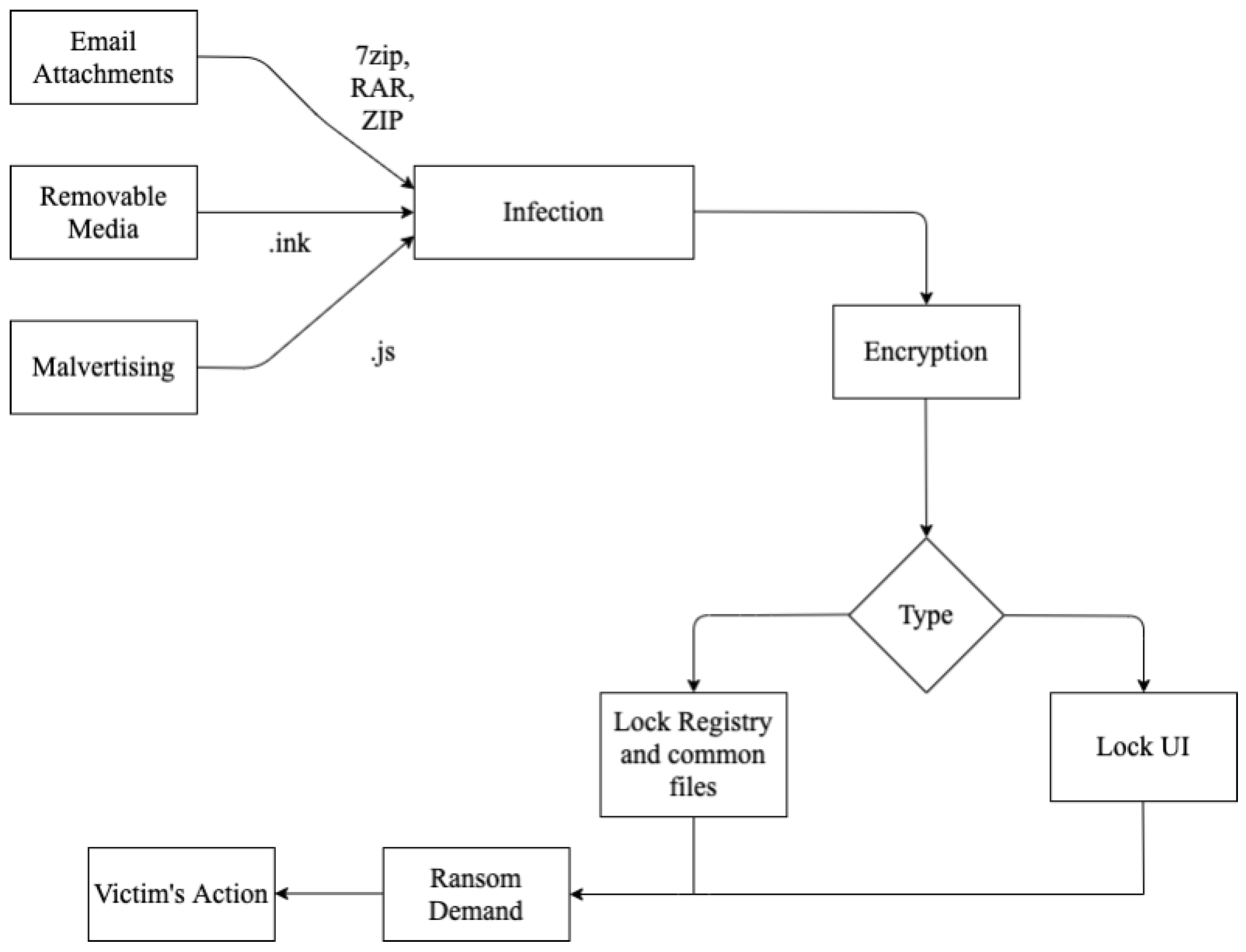
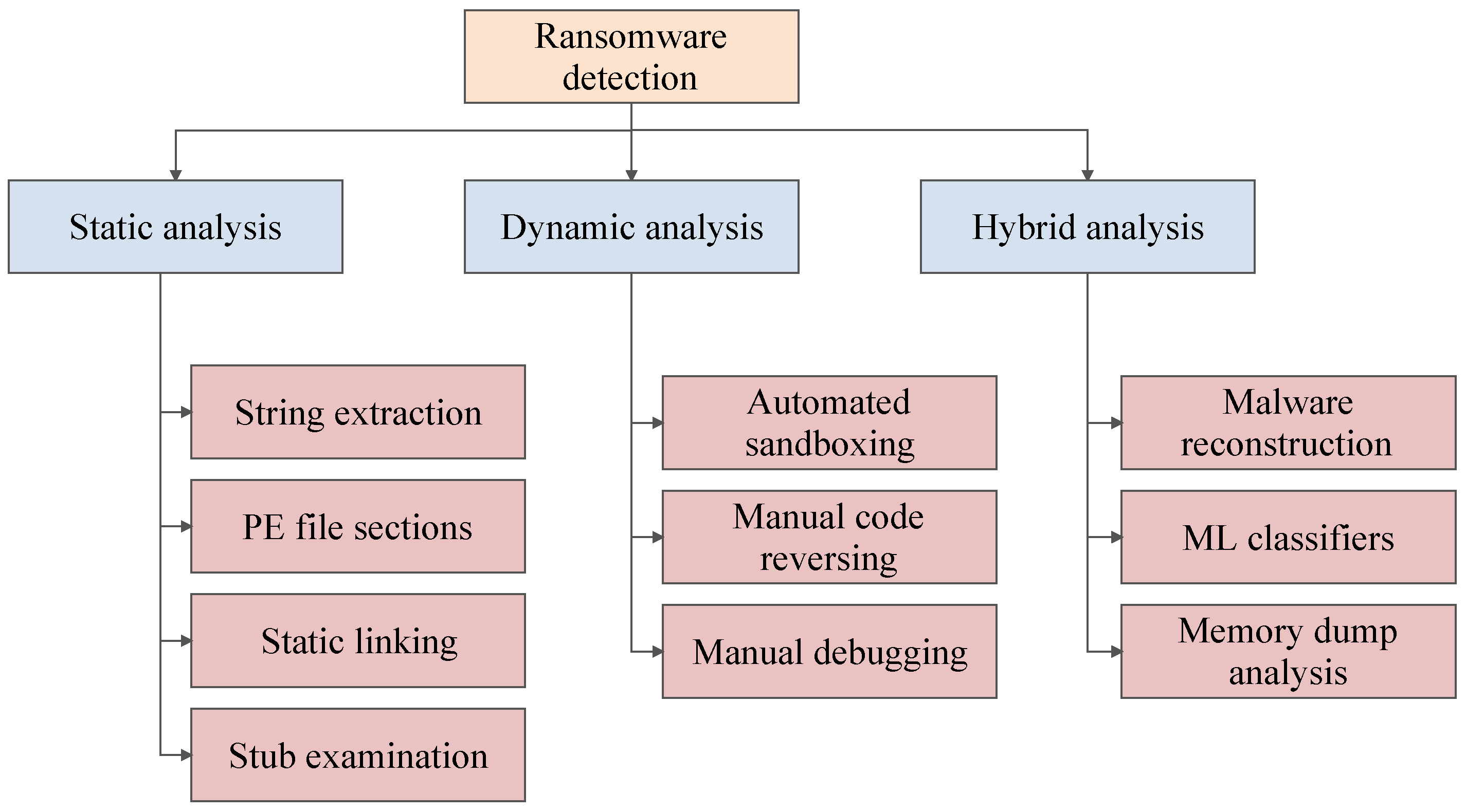
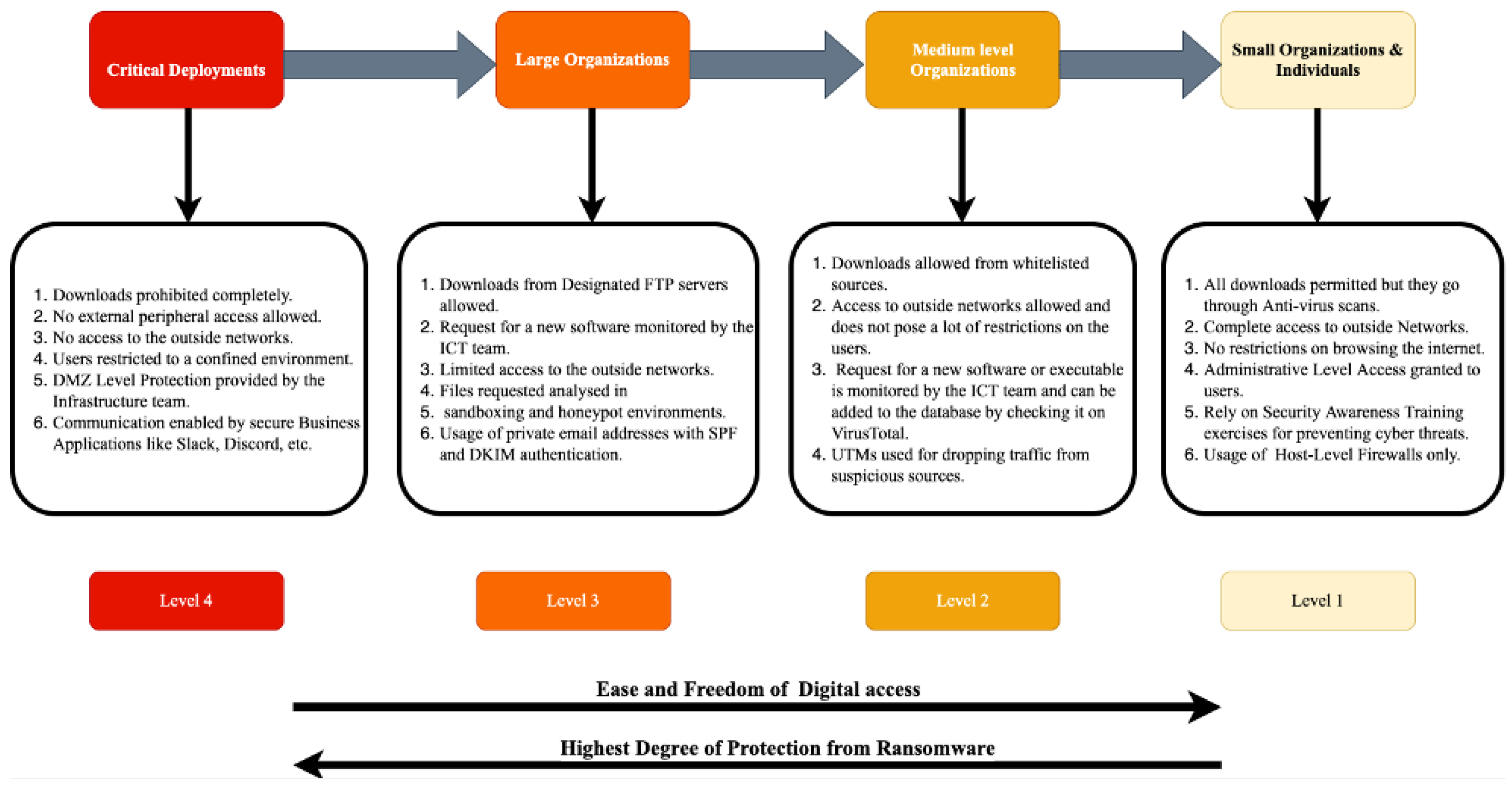
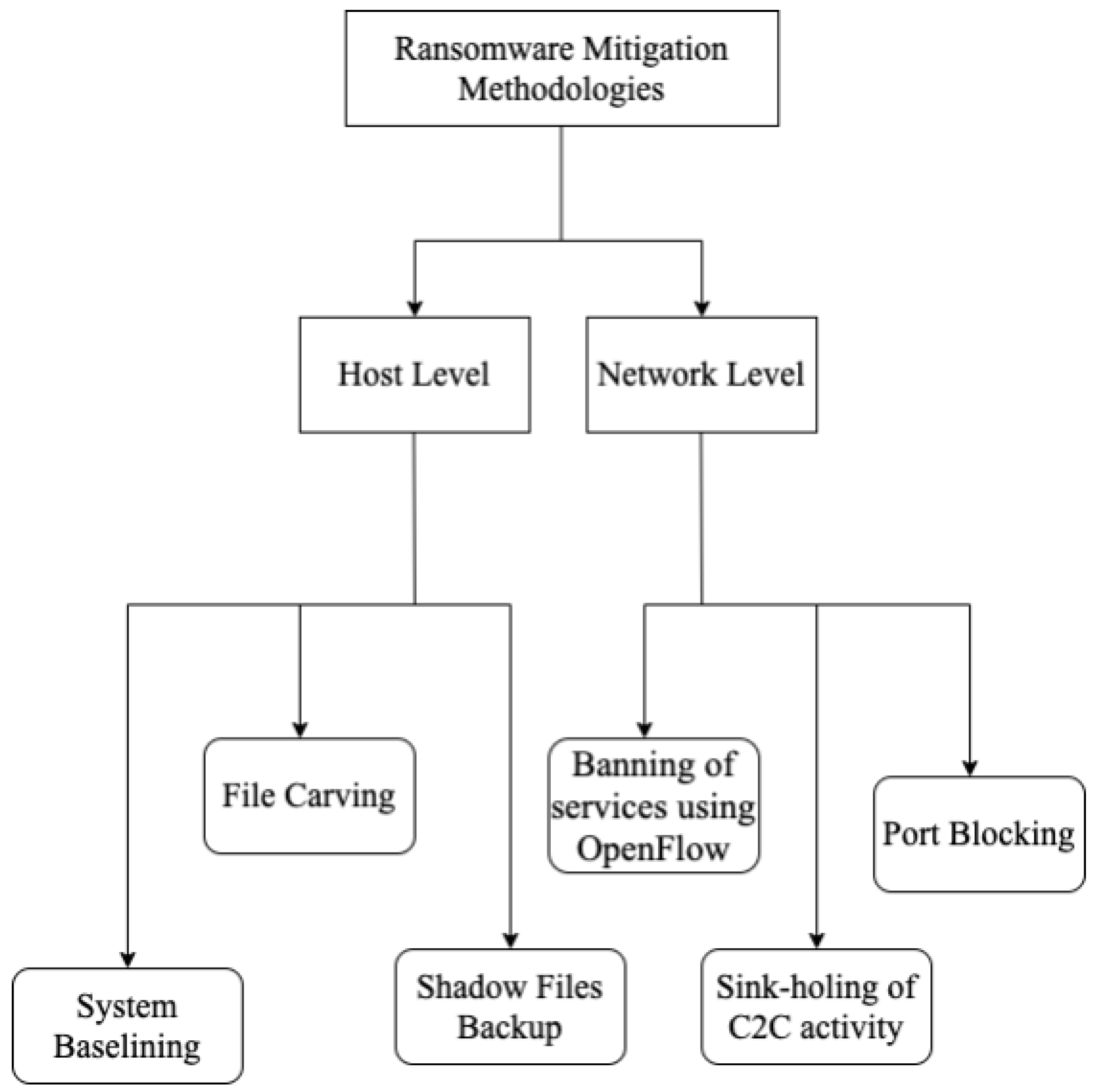
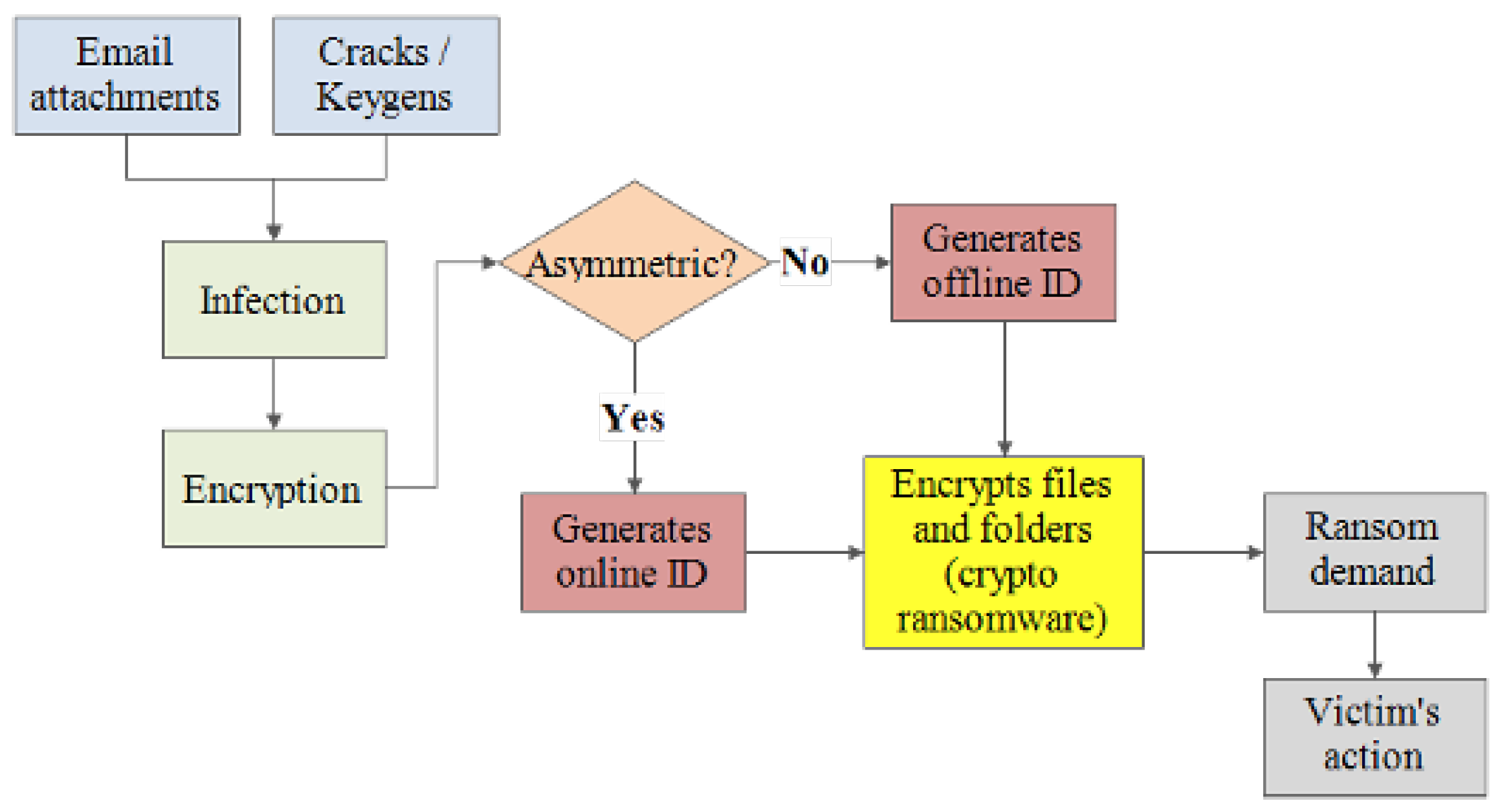
| Research Contributions | Reference Section Numbers |
|---|---|
| Contribution 1 | Section 4 |
| Contribution 2 | Section 4.2 |
| Contribution 3 | Section 5 |
| Contribution 4 | Section 6 |
| AES | Advanced Encryption Standard |
| AIDS | Auto Immune Deficiency Syndrome |
| AOL | America Online |
| ASCII | American Source Code for Information Interchange |
| BBC | British Broadcasting Corporation |
| C2C | Command & Control |
| CTB | Curve Tor Bit-locker |
| DAM | Detect Avoid Mitigate |
| DLL | Dynamic Link Library |
| DNS | Domain Name Service |
| IOC | Indicators of Compromise |
| IT | Information Technology |
| MBR | Master Boot Record |
| ML | Machine Learning |
| MSN | Microsoft Network |
| P2P | Peer-to-Peer |
| PC | Personal Computer |
| Portable Document Format | |
| RaaS | Ransomware as a Service |
| RSA | Rivest Shamir Adleman |
| SDN | Software Defined Networking |
| SMB | Server Message Block |
| TCP | Transmission Control Protocol |
| TOR | The Onion Routing |
| URL | Uniform Resource Locator |
| UTM | Unified Threat Management |
| Researcher | Contribution | Pros | Cons |
|---|---|---|---|
| Aurangzeb et al. [25] | Evaluated attack methodologies for Windows Based Ransomware families. | The authors discussed all possible exploit vectors and kits used in creation of Windows based Ransomware families. | They did not specifically propose any technical solutions required to counter Ransomware. |
| Tailor et al. [26] | Analyzed different encryption techniques used by modern Ransomware strands so as to develop better detection strategies. | The authors presented a comprehensive overview of different encryption techniques used by both Locker and Crypto Ransomware families. | Techniques proposed by the authors could include some implementation based details for effective detection of Ransomware. |
| Tandon et al. [27] | Explained the modus-operandi and architecture of typical Ransomware attacks. | The authors gave a detailed view of MS-017 exploit and how it eventually used Double Pulsar to cause the spread of WannaCry. | Discussions are presented in the context of a single Ransomware. Broad-based countermeasure strategies not provided. |
| Genç et al. [28] | Discussed the current Ransomware mitigation strategies and evaluated their effectiveness. | The authors explained the latest ransomware strands which can be generated using rootkits in addition to Ransomware of things. | Novel mitigation strategies for obfuscated Ransomware strands not suggested. |
| Oz et al. [29] | The authors summarized all the different Ransomware families based on the exploits that helped them propagate. | The tables and the summaries presented by the authors can be adopted by researchers to create new mitigation frameworks. | The authors did not discuss the solutions with respect to the latest families that use offline encryption techniques. |
| Kok et al. [30] | The authors’ research was focused on finding out the effectiveness of preexisting detection techniques and thus highlighted the requirement of an ML based solution to create better detection techniques. | The authors explained the Ransomware lifecycle in a novel manner and mapped it to the different techniques to find out their effectiveness. | The authors outlined an ML based solution using linear regression but did not technically explain its effectiveness over existing solutions. |
| The proposed survey | The authors discuss all possible Ransomware propagation techniques and put forth a Ransomware avoidance Continuum that can be adopted by organizations and individuals alike. | The authors presented a good overview of the adversary methodologies and performed a case study of one of the recent Ransomware strands, Djvu. Novel suggestions are put forth to contain the spread of Ransomware. | - |
| Detection Technique/ Tool | Mode of Analysis | Analysis Methodology | Limitations of the Methodology | Ransomware Samples Analyzed |
|---|---|---|---|---|
| CRSTATIC [31] | Static analysis | Pre-parsing of PE to find out the system calls, relocation and byte read operations. | Only able to detect Crypto Ransomware family. | Jigsaw, Shatana, Cryptomix |
| GreatEatlon [32] | Static analysis | Identification of code flows followed by inspecting API usage. | The methodology cannot detect the families that use signature evasion techniques. | Contagio-Mobile |
| ML-Based hybrid Android analysis using Naïve Bayes [54] | Static & Dynamic analysis | Opcode frequency detection and evaluation of system calls and CPU usage to determine the malicious nature of Android Binaries. | The datasets used do not contain the latest Android Ransomware families | Svpeng, scare package, simple locker |
| Third-Gen hybrid detection approach [55] | Static & Dynamic analysis | Examination of binary against fixed parameters before running it and then sandboxing it to detect the W-32 dropper file. | The Cerber W-32 dropper has many variants and thus this approach can only detect the W-32 V1. | Cerber |
| EldeRan [38] | Dynamic analysis | Parameter matching during the initial phase of infection followed by feature selection using Mutual information criteria. | Since it focuses only on detection of early phases of Ransomware, it fails to capture the obfuscated encryptors and export files. | Citroni, Kollah, Kovter |
| ML-based monitoring technique [40] | Dynamic analysis | Probabilistic supervised Ransomware classification of anomalous network patterns. | The traffic patterns captured can have exploit kits hidden via steganographic techniques | Petya, BadRabbit, Power Ghost |
| ML-based detection using WEKA and T-Shark [56] | Dynamic analysis | ML analysis of Windows Ransomware network traffic followed by ML classifiers to achieve high detection rate. | WEKA used limited datasets and was not able to distinguish between the two major categories of Ransomware. | Padcrypt, Teslacrypt, Locky |
| Dynamic API call-based detection approach [57] | Dynamic analysis | Monitoring of dynamic API calls using the CF graphs along with deployment of data mining techniques to detect unknown Ransomware families. | New Ransomware families built via anti-analysis techniques cannot be detected by this approach. | Wannacry, Locky |
| Markov & Random Forest model-based detection [58] | Dynamic analysis | Detection of Windows API sequence call patterns through Markov model and deploy Random Forest model to control FPR and FNR. | The range resulting from Random Forest model cannot give a perfect estimation and can lead to benign binaries being classified as malicious. | CryptoLocker |
| UNVEIL [59] | Dynamic analysis | Generation of an artificial sandboxing environment which interacts with binaries to determine their behaviour. | The artificial sandboxing environment cannot always detect DLL hijacking. | SilentCrypt |
| Name | Djvu |
| Ransomware Type | Crypto Family |
| File Extensions | .djvu, .kasp, .nopsk, .tfude, etc. |
| Author Email | helpshadow@india.com, restoredjvu@india.com, helpshadow@firemail.cc |
| Delivery Method | Email Attachments, Cracks, Keygens, Packaged Software |
| Decryption | Offline IDs: yes, Online IDs: no |
| IOC | Changed Checksums, .txt files appearing on the Desktop |
| Ransom Amount | $800 |
| Detect | Avoid | Mitigate |
|---|---|---|
| Static Analysis – checksums, emails, APIs, malicious strings | AI-based Cyber-hygiene assistants | System backup and restore |
| Dynamic Analysis – Ghidra, Wireshark & Process Hacker for reverse engineering, network analysis and API call analysis | Sandboxed downloads - analyze all downloads via ANY.RUN analyzer and then install | Scheduled disk mirroring |
| Custom Dynamic Analysis – DJVU performance profile tracking and matching | Firewalls and anti-Ransomware software | Decrypting files by reverse engineering the strand (improbable) |
Publisher’s Note: MDPI stays neutral with regard to jurisdictional claims in published maps and institutional affiliations. |
© 2021 by the authors. Licensee MDPI, Basel, Switzerland. This article is an open access article distributed under the terms and conditions of the Creative Commons Attribution (CC BY) license (https://creativecommons.org/licenses/by/4.0/).
Share and Cite
Kapoor, A.; Gupta, A.; Gupta, R.; Tanwar, S.; Sharma, G.; Davidson, I.E. Ransomware Detection, Avoidance, and Mitigation Scheme: A Review and Future Directions. Sustainability 2022, 14, 8. https://doi.org/10.3390/su14010008
Kapoor A, Gupta A, Gupta R, Tanwar S, Sharma G, Davidson IE. Ransomware Detection, Avoidance, and Mitigation Scheme: A Review and Future Directions. Sustainability. 2022; 14(1):8. https://doi.org/10.3390/su14010008
Chicago/Turabian StyleKapoor, Adhirath, Ankur Gupta, Rajesh Gupta, Sudeep Tanwar, Gulshan Sharma, and Innocent E. Davidson. 2022. "Ransomware Detection, Avoidance, and Mitigation Scheme: A Review and Future Directions" Sustainability 14, no. 1: 8. https://doi.org/10.3390/su14010008
APA StyleKapoor, A., Gupta, A., Gupta, R., Tanwar, S., Sharma, G., & Davidson, I. E. (2022). Ransomware Detection, Avoidance, and Mitigation Scheme: A Review and Future Directions. Sustainability, 14(1), 8. https://doi.org/10.3390/su14010008







